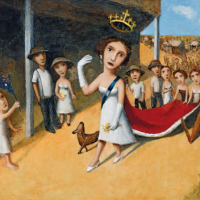33. GARRY SHEAD

Although Garry Shead could be broadly described as a republican and his Royal Suite paintings promptly entered the Australian republican debate of the late 1990s, this was not the primary intention of the series. It had been a long time in the making, in fact about forty years, and employed the metaphor of the royal visit of 1954 to explore a wide range of themes. Implicit in the series is a discussion of childhood sexuality, the oedipal complex with the related patricidal wish and the desire to reclaim the queen. In a sense they are also history paintings, looking back to the Australia of the 1950s when the omnipresent figure of Menzies dominated so much. Underpinning this series is an awareness of the cold war and the Petrov affair, John Anthills pioneering ballet Corroboree, which was commissioned for the royal visit and which brought the heritage of Aboriginal music and dance into mainstream cultural life, and also the whole complex tapestry of Australian society of the time. The Royal Suite paintings reflect something of a naive innocence of vision, something which was possible when seen through the eyes of a twelve year old boy.1
When Queen Elizabeth II visited Australia in February 1954, she was the first reigning monarch to set foot on Australian soil. Following the death of her father in 1952, the newly crowned Queen had taken over duties originally planned for King George VI. During this visit, her itinerary covered the Australian Capital Territory, New South Wales, Tasmania, Victoria, Queensland, South Australia, Western Australia and seventy regional towns. It is estimated that the monarch travelled over sixteen thousand kilometres during the tour, allowing some seventy five percent of the Australian population to see the Queen at least once during the tour. The support shown by the public during Queen Elizabeth IIs visit was expressed by the then Prime Minister, Robert Menzies, in the following statement, It is a basic truth that for our Queen we have within us, sometimes unrealised until the moment of expression, the most profound and passionate feelings of loyalty and devotion. It does not require much imagination to realise that when eight million people spontaneously pour out this feeling they are engaging in a great act of common allegiance and common joy which brings them closer together and is one of the most powerful elements converting them from a mass of individuals to a great cohesive nation. In brief, the common devotion to the Throne is a part of the very cement of the whole social structure.2
The Royal tour of Australia in 1954 was, at the time, the single biggest event the nation had hosted. The organisational undertaking was immense, with all correspondence between those involved done by hand-written letters and telephone calls. Official printed programs from the Royal tour stated that all those responsible for an event were to synchronise their watches with the ABC time signals at 9am each day.3 The eight week tour took place during summer when temperatures reached upwards of forty degrees centigrade in some areas of Australia. Despite the punishing heat and humidity, the monarch was rarely seen without her elbow length gloves, decorative hats and elegant heels on at all times. The weather conditions, coupled with the unrelenting schedule of engagements, would have been taxing on the Royal couple who were still familiarising themselves with their new roles and responsibilities. Art historian, Sasha Grishin, refers to the figure of Queen Elizabeth in Sheads Royal series paintings as absurd4 - she is completely at odds with this strange, alien environment as she travels through the country, coming face-to-face with some of the native wildlife.
Queen and Royal Procession II painted in 1997, the early period of the Royal Suite paintings, presents a tableau of Sheads royal iconography. While the participants appear recognisable through their attributes and insignia, things are not what they seem. The monarch clutches a posy of sulphur-yellow wattle as she glides down a red carpet, a regal train draping behind her. The presence of the cattle dog and kangaroo are reminders of the stark contrast between Englands green, verdant pastures and this strange, new, sunburnt country. The setting is a typical country town, lined with local onlookers and young children waving Australian flags. The artist emphasises the displacement of the monarch by placing her amongst this motley mix of characters, if Australia appeared strange, monstrous and grotesque to the Queen, the white goddess herself appeared as strange and not belonging to this land.5
The dominant mood in the present work is one of cheerful optimism, the Queens first visit to Australia as the reigning monarch. As with the best of Sheads Royal Suite paintings, Queen and Royal Procession II is graced with a lyrical charm and gentle sensousness. He is painting an allegory, that of the naive belief in the white goddess from a foreign land. Perhaps on the simplest level, the series is about a quest for beauty and a lost innocence6
Footnotes
1. Grishin, S., Garry Shead, Encounters with Royalty, Craftsman House, Sydney, 1998, p.22
2. The Queens Visit is First by a Reigning Monarch, Sydney Morning Herald, 4 February 1954, p.2, Royal Tour Supplement
3. ibid
4.Gary Shead: Amazed and Amused, Australian Art Collector, Issue 14, October-December 2000, p.81
5. Grishin, S., Garry Shead, Encounters with Royalty, Craftsman House, Sydney, 1998, p.26
6. ibid, p.29
Caroline Jones MArtAdmin